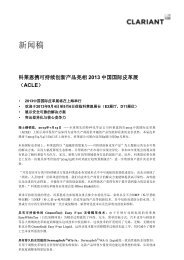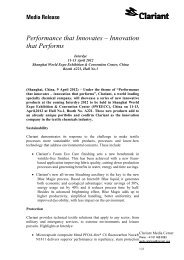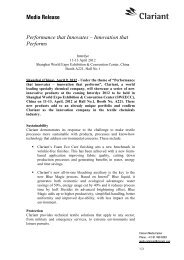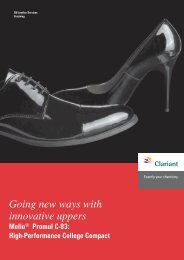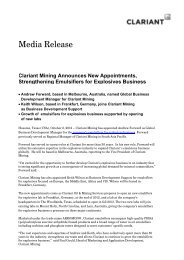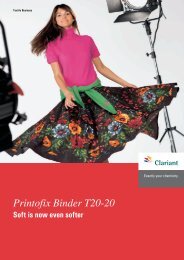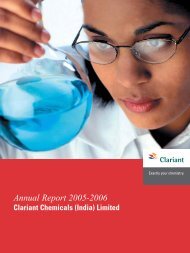Colour Chronicle - June 2013
Colour Chronicle - June 2013
Colour Chronicle - June 2013
You also want an ePaper? Increase the reach of your titles
YUMPU automatically turns print PDFs into web optimized ePapers that Google loves.
TEXTILE<br />
Summary of the key features of modern<br />
ultra low liquor ratio machines<br />
• The liquor ratio is reduced from 8:1 to 4:1<br />
for cotton processing.<br />
• Reduced fabric tension and friction for<br />
better fabric running conditions in the<br />
chamber (tangle free).<br />
• Contact free dyeing (between the fabric and<br />
bulk volume of the dye bath). Dyeing takes<br />
place in the nozzle.<br />
• Shorter processing time (e.g. faster loading/<br />
unloading, heating/cooling, filling/<br />
draining).<br />
• Reduced energy, water and chemical<br />
consumption.<br />
• Novel, water saving rinsing systems e.g.<br />
Then® direct rinsing ‘shower principle’.<br />
• Low liquor ratio conditions even when the<br />
machine is under-loaded.<br />
• Improved microprocessor control.<br />
Process and dyestuff requirements<br />
When dyeing at low liquor ratio, the selection<br />
of the reactive dyes is critical as they need to<br />
fulfill the following high requirements:<br />
Process requirements<br />
• Only a low amount of liquor is available to<br />
prepare the dyestuff solution (LR 1.5:1).<br />
• Excellent shade transfer from lab (LR<br />
8:1) to production (LR 4:1) and shade<br />
reproducibility from bulk to bulk.<br />
• Perfectly level dyeing with very good fabric<br />
appearance must be achieved at LR 4:1.<br />
• Rinsing and washing off at low liquor ratio.<br />
All the key points at one glance<br />
Drimaren® Electrolyte Diffusion Migration Substantivity Exhaustion Fixation<br />
Stability<br />
(80g/l Na 2<br />
SO 4<br />
) [%] [%] [%] [%]<br />
G. Yellow HF-CD >35 g/l 7 5 59 88 82<br />
Orange HF-2GL >35 g/l 5.5 4 61 96 91<br />
Red HF-6BL >35 g/l 7 4-5 60 91 81<br />
Red HF-3B >35 g/l 5.5 4-5 55 97 93<br />
Blue HF-RL >35 g/l 5.5 4-5 68 93 83<br />
Blue HF-2B >35 g/l 5.5 4-5 64 91 86<br />
Dark Blue HF-CD >35 g/l 5.5 4 55 90 82<br />
Navy HF-GN >35 g/l 7 4-5 60 92 88<br />
Requirements of reactive dyes<br />
• High solubility in presence of salt and alkali<br />
(solution stability).<br />
• Low influence of salt concentration and<br />
liquor ratio on dye yield (high neutral<br />
substantivity).<br />
• Very good migration (levelling) properties,<br />
on the fibre, during the neutral phase. High<br />
reactivity and fixation in the alkaline phase.<br />
• Very high fixation reactive dyes requiring<br />
less salt. Very good diffusion and low<br />
substantivity of the hydrolyzed dye.<br />
Drimaren® HF reactive dyes meet the<br />
needs of Ultra Short Liquor Ratio<br />
dyeing:<br />
• High solution stability (in the presence<br />
of salt).<br />
• High neutral substantivity.<br />
• Very good migration.<br />
• Very good diffusion.<br />
• High reactivity and degree of fixation.<br />
• Excellent wet fastness can be achieved by<br />
rinsing at a temperature of only 60ºC.<br />
• By adopting Clariant’s Drimaren® HF<br />
range of poly-reactive dyes, on modern<br />
ultra low liquor ratio, exhaust dyeing<br />
machinery, vast savings in water, energy<br />
and chemical consumption are possible,<br />
reducing the environmental footprint of the<br />
textile produced.<br />
7 COLOUR CHRONICLE__JUNE <strong>2013</strong>



